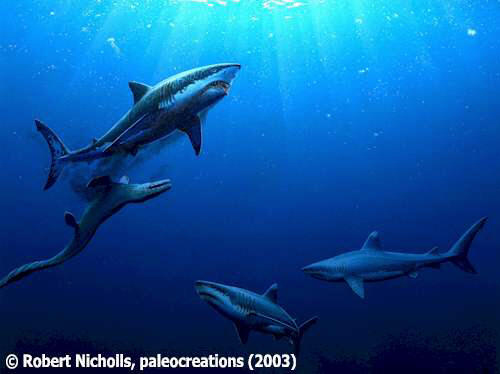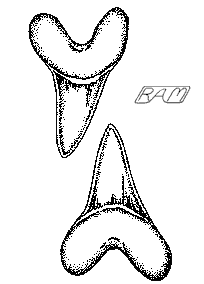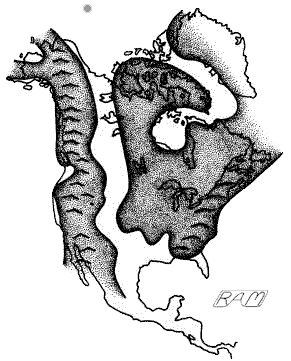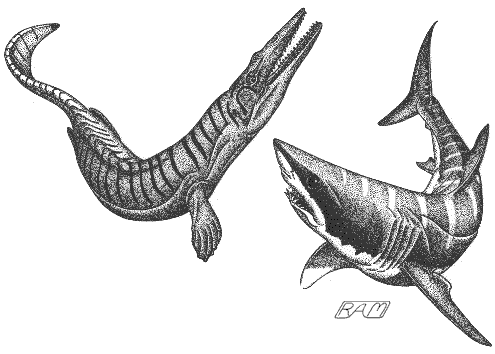Cretoxyrhina mantelli

"Cretaceous Jaws", by Robert Nicholls. In this reconstruction, Cretoxyrhina mantelli is envisioned as a robust mako that has just ripped the belly out of a mosasaur; in the background, a pair of Squalicorax kaupi skulk, awaiting an opportunity to scavenge the carcass. Used with the gracious permission of the Robert Nicholls, who reserves all rights to this image.

Fossil Teeth of the 'Ginsu Shark" |
During the late Cretaceous, about 100 million years ago, there arose a ferocious expression of lamnoid predatory prowess named Cretoxyrhina mantelli. Growing to a length of 15 to 18 feet (4.5 to 5.5 metres), C. mantelli rivaled the modern great white shark in sheer size. Most Cretaceous sharks are known primarily from isolated fossilized teeth. In contrast, several nearly complete skeletons of C. mantelli have been discovered. These astonishing fossil finds include disarticulated clusters of vertebrae with associated upper and lower tooth sets lying in clear arcs, giving a vivid impression of Cretoxyrhina's body length and mouth width. Remarkably, paleontologists have also discovered at least two mineralized impressions of C. mantelli skin, with tooth-like dermal denticles still anchored in place. From these and other, less spectacular finds, we know that Cretoxyrhina mantelli lived globally in oceanic and coastal areas, including the Western Interior Sea (sometimes known by more evocative name, Sundance Sea) which had flooded inland North America during the Mesozoic.
|
|
Kansas is surely one of the last places on Earth one would go looking for sharks ("They're not in Kansas anymore Toto!"). But fossil hunter Mike Everhart has collected hundreds of Cretoxyrhina mantelli teeth from late Cretaceous deposits in the western part of that state, indicating that this species was once quite abundant there. Everhart named C. mantelli the 'Ginsu Shark', in reference to its knife-like 2-inch (5-centimetre) recurved teeth. Each of these teeth had a smooth-edged blade and resembled those of a mako, but were much broader and more massive with an unusually thick enameloid coating. Such teeth clearly enabled it to feed on large, active, and well-armed prey.
A recent paper by paleontologist Kenshu Shimada reviewed the paleoecology of Cretoxyrhina mantelli from late Cretaceous deposits in Kansas. According to Shimada, associated fossil remains with evidence of digestive damage suggest that probable fish prey of C. mantelli included the massively jawed, 14-foot (4.25-metre) long Xiphactinus, which resembled a dagger-toothed tarpon and was a powerful predator in its own right. Based on a few tooth-scarred, associated mosasaur vertebrae, Shimada suggests that C. mantelli also tackled these 10- to 40-foot (3- to 12- metre) long marine reptiles of the late Cretaceous. While it is tempting to imagine titanic undersea battles between a giant shark and a sea dragon, it seems far more likely that Cretoxyrhina more commonly fed on large pelagic bony fishes, taking juvenile mosasaurs when the opportunity arose, and perhaps even dining on the occasional long-necked plesiosaur. Shimada concluded that Cretoxyrhina mantelli occupied a top predatory niche comparable to that of the modern White Shark (Carcharodon carcharias). Despite its fearsome size and armament, C. mantelli did not long survive, becoming extinct by about 90 million years ago.
A ferocious predatory encounter between the 'Ginsu Shark' Cretoxyrhina mantelli, (reconstructed here as a giant, striped mako) and the mosasaur Clidastes. The mosasaur is redrawn from an original illustration by Gregory Paul - see gspauldino.com. Such titanic battles may never have occurred, but they are fun to imagine.


